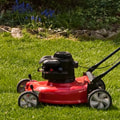A well-maintained lawn is the pride of any homeowner, and mowing is one of the most essential aspects of lawn care. However, determining the ideal frequency for mowing can be challenging, as it depends on various factors such as grass type, season, and growth rate. Mowing too often can stress the grass, while mowing too infrequently can lead to overgrowth and a decline in lawn health. Understanding the right balance is crucial for achieving a lush, green lawn that enhances the overall aesthetics of your property. In this discussion, we explore how often lawns should be mowed and the key considerations for maintaining optimal grass health throughout the year.
Grass Type and Mowing Frequency
The type of grass growing on your lawn is the primary factor that influences how often you should mow. Different grasses grow at varying rates and have unique height preferences. For instance, warm-season grasses like Bermuda and Zoysia thrive in hot temperatures and grow quickly during summer, often requiring mowing every 5 to 7 days during their peak growth season. Cool-season grasses, such as Kentucky Bluegrass and Fescue, tend to grow more actively in the cooler months of spring and fall. These types might also need weekly mowing during these periods but less frequent cutting in summer and winter when their growth slows down.
Understanding your grass type allows you to tailor your mowing schedule to match its growth pattern, ensuring that the lawn remains healthy and attractive. Cutting the grass too short or too infrequently can lead to stress and create an environment for weeds and pests to thrive.
The One-Third Rule
One of the most effective guidelines for mowing frequency is the one-third rule. This rule suggests that you should never cut more than one-third of the grass height in a single mowing session. Removing too much of the grass blade at once can stress the grass and hinder its ability to photosynthesize, weakening the lawn over time. For example, if your grass is three inches tall, it is best to mow it down to two inches rather than shorter.
Following the one-third rule ensures that you are maintaining the optimal height for your grass while also encouraging thicker growth. Thicker grass naturally shades the soil, helping to retain moisture and prevent weeds from sprouting. By adhering to this rule, you can determine the mowing frequency based on how quickly your grass grows, which will vary depending on weather conditions and the season.
Seasonal Adjustments
Adjusting your mowing schedule according to the season is crucial for maintaining a healthy lawn. In spring, when the grass begins to grow more actively, it is typically necessary to mow every 5 to 7 days to keep up with the rapid growth. As temperatures rise in summer, warm-season grasses may continue to require frequent mowing, but cool-season grasses might slow down, allowing you to reduce mowing frequency.
During fall, the growth rate of cool-season grasses picks up again, necessitating weekly mowing until temperatures drop. In winter, most grasses enter a dormant phase, and mowing can often be reduced to once every few weeks or even less, depending on the climate and grass type. By being flexible with your schedule and adjusting it based on seasonal growth patterns, you can ensure that the lawn remains healthy without over-stressing the grass.
Impact of Weather Conditions
Weather conditions play a significant role in determining how often the lawn should be mowed. Rainy periods can cause grass to grow faster, which might require more frequent mowing. However, it is essential to avoid mowing when the grass is wet, as this can lead to uneven cuts and damage to the lawn. Wet grass tends to clump together, making it difficult to achieve a clean cut and increasing the risk of disease.
On the other hand, during dry spells or drought conditions, grass growth may slow down considerably. In such cases, it is advisable to mow less frequently and raise the mowing height to prevent the grass from becoming too stressed. Keeping the grass slightly taller helps it retain moisture and reduces the risk of browning during hot and dry weather. Monitoring weather patterns and adjusting your mowing routine accordingly helps maintain a resilient and healthy lawn throughout the year.
Tools and Lawn Care Equipment
The tools you use for mowing can also affect how often the lawn needs to be mowed. A sharp mower blade is essential for clean cuts, which reduce the likelihood of disease and promote healthy growth. Dull blades can tear the grass, making it more susceptible to pests and stress. Regularly maintaining your lawnmower and ensuring that the blades are sharpened every few weeks is an important aspect of effective lawn care.
Additionally, the mowing pattern can influence how often you mow. Changing the mowing direction each time prevents the grass from leaning in one direction and encourages upright, even growth. Alternating patterns also reduces soil compaction, improving the overall health of the lawn.
Conclusion
Determining how often to mow the lawn is not a one-size-fits-all answer; it varies based on grass type, season, weather conditions, and mowing practices. By understanding your grass type and following guidelines like the one-third rule, you can tailor your mowing frequency to meet the needs of your lawn. Seasonal adjustments, weather monitoring, and proper mowing techniques are all essential for maintaining a vibrant, healthy lawn. Consulting with professionals, such as Bulwark Fencing Pros Fence Contractors, can also help in creating a cohesive outdoor space that complements your lawn’s aesthetic while providing practical solutions like fencing that integrates seamlessly with your landscape. By combining regular maintenance with a thoughtful approach to lawn care, you can enjoy a lush, green lawn that enhances the beauty of your property all year round.






